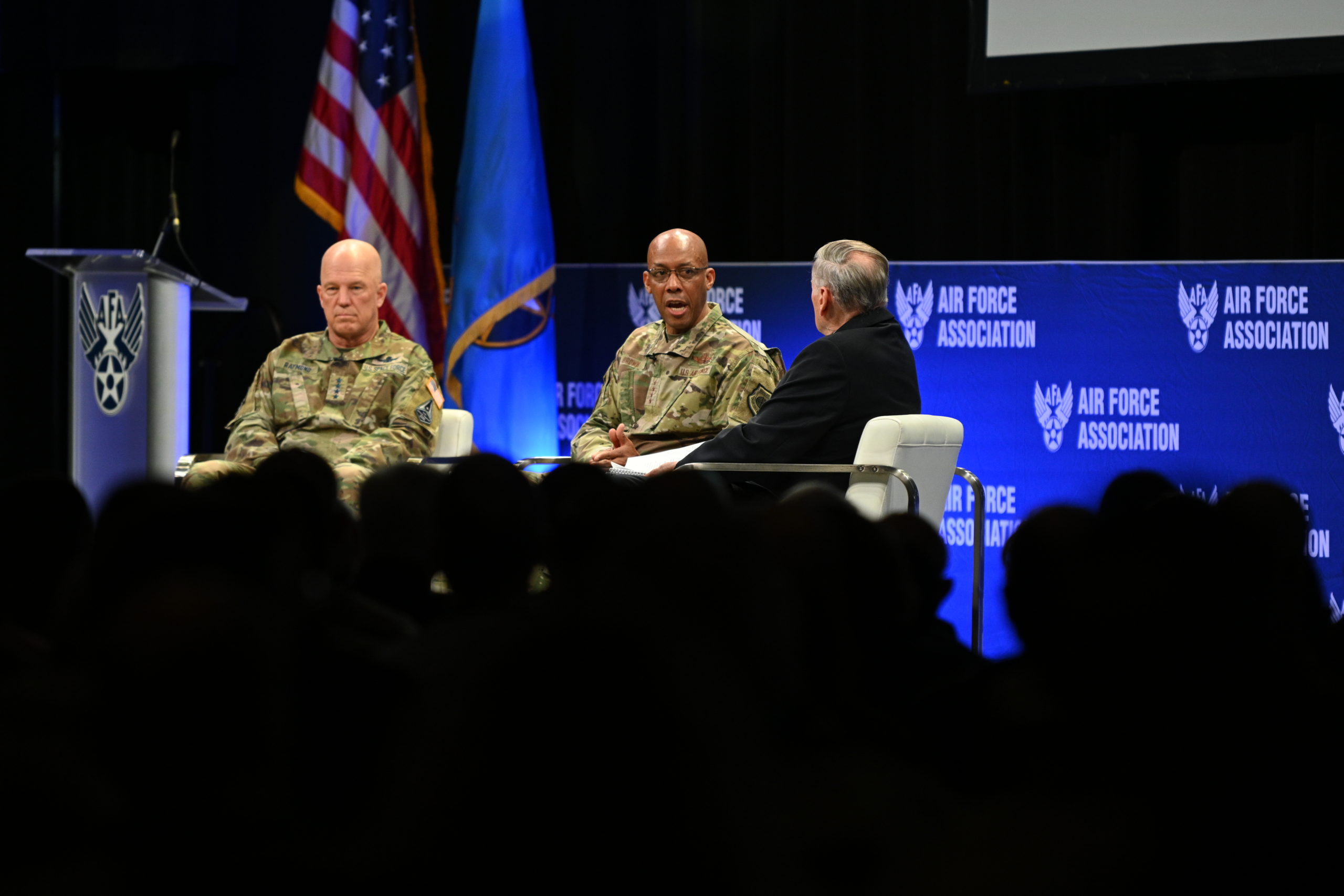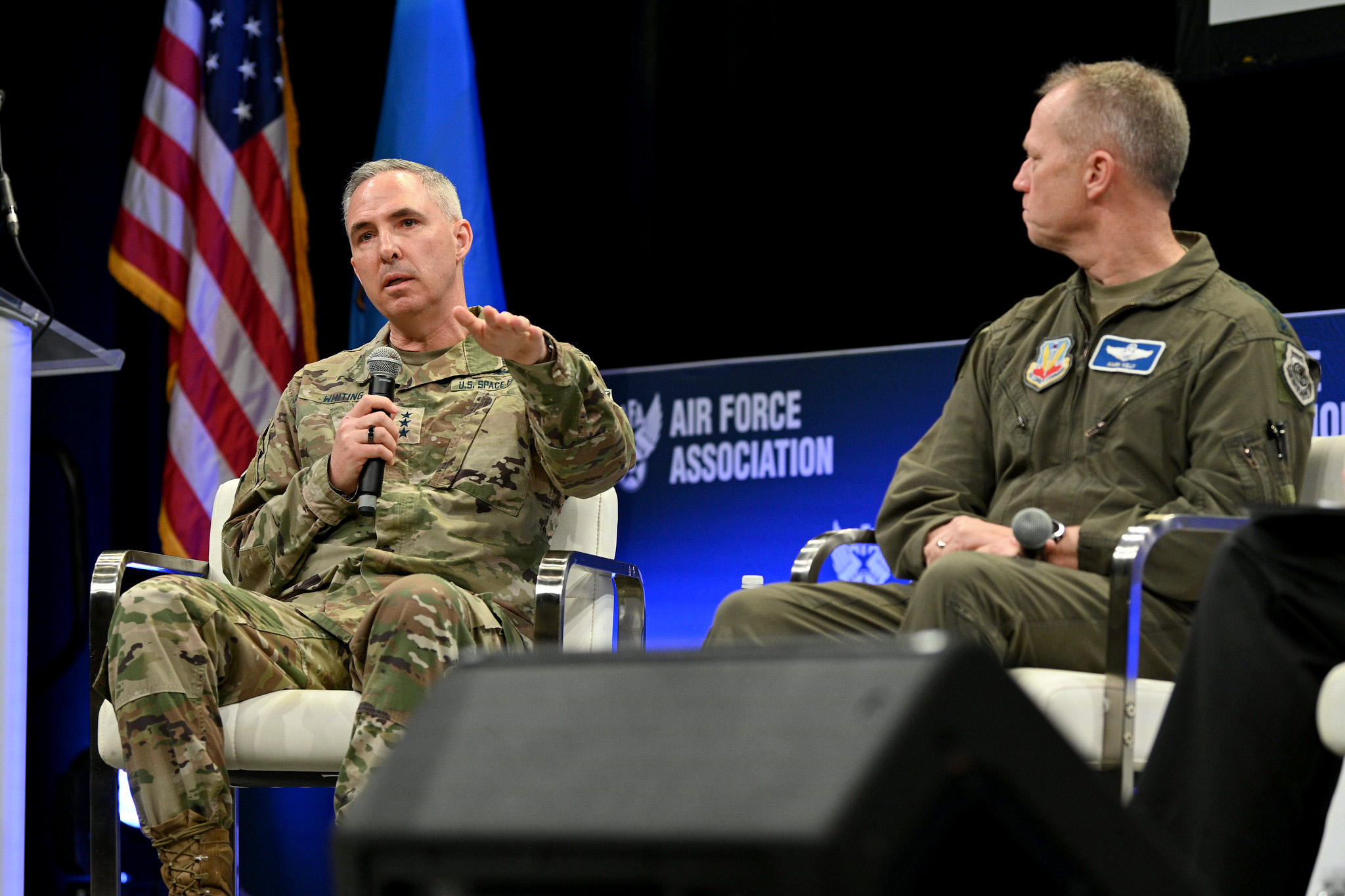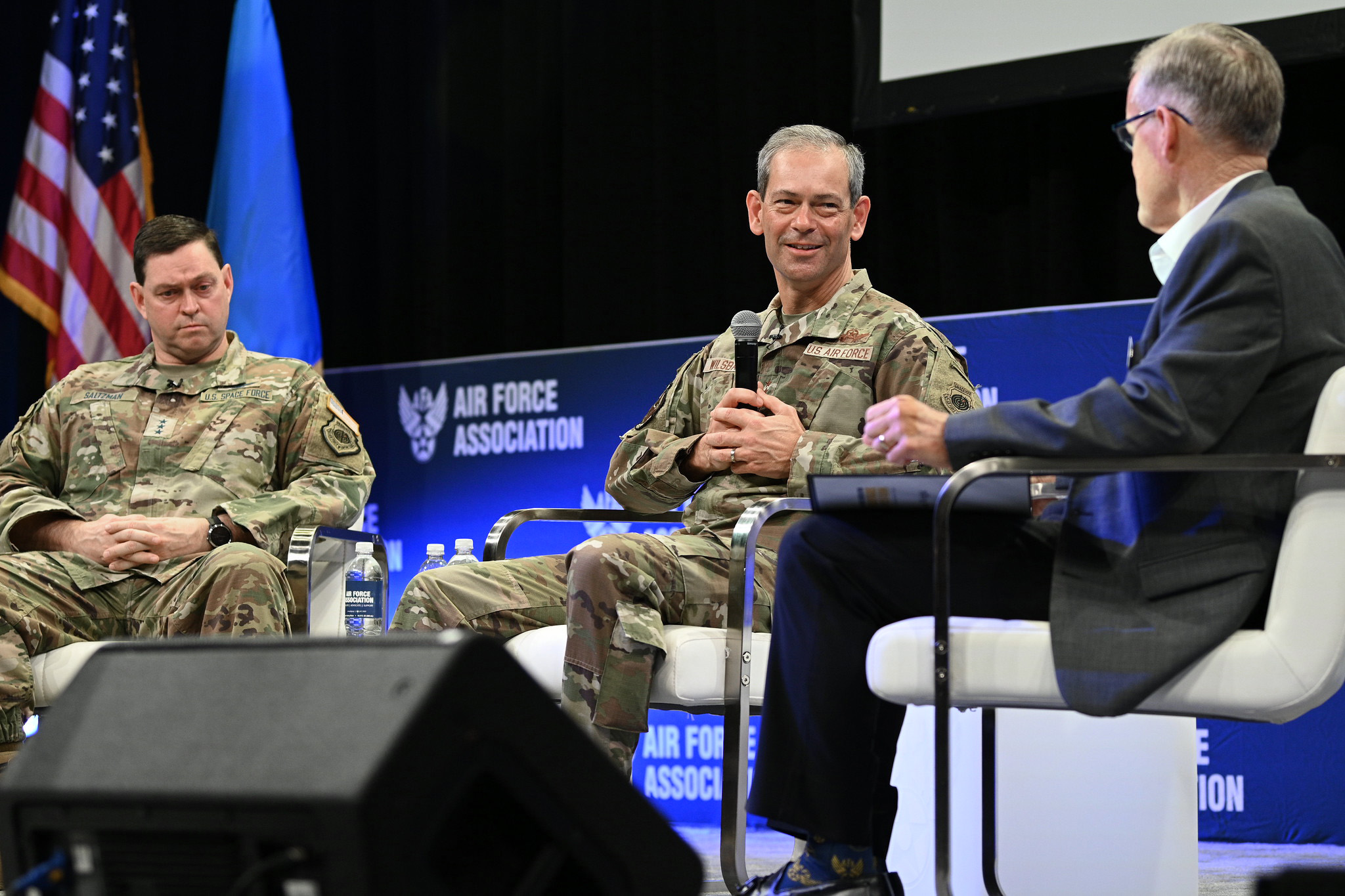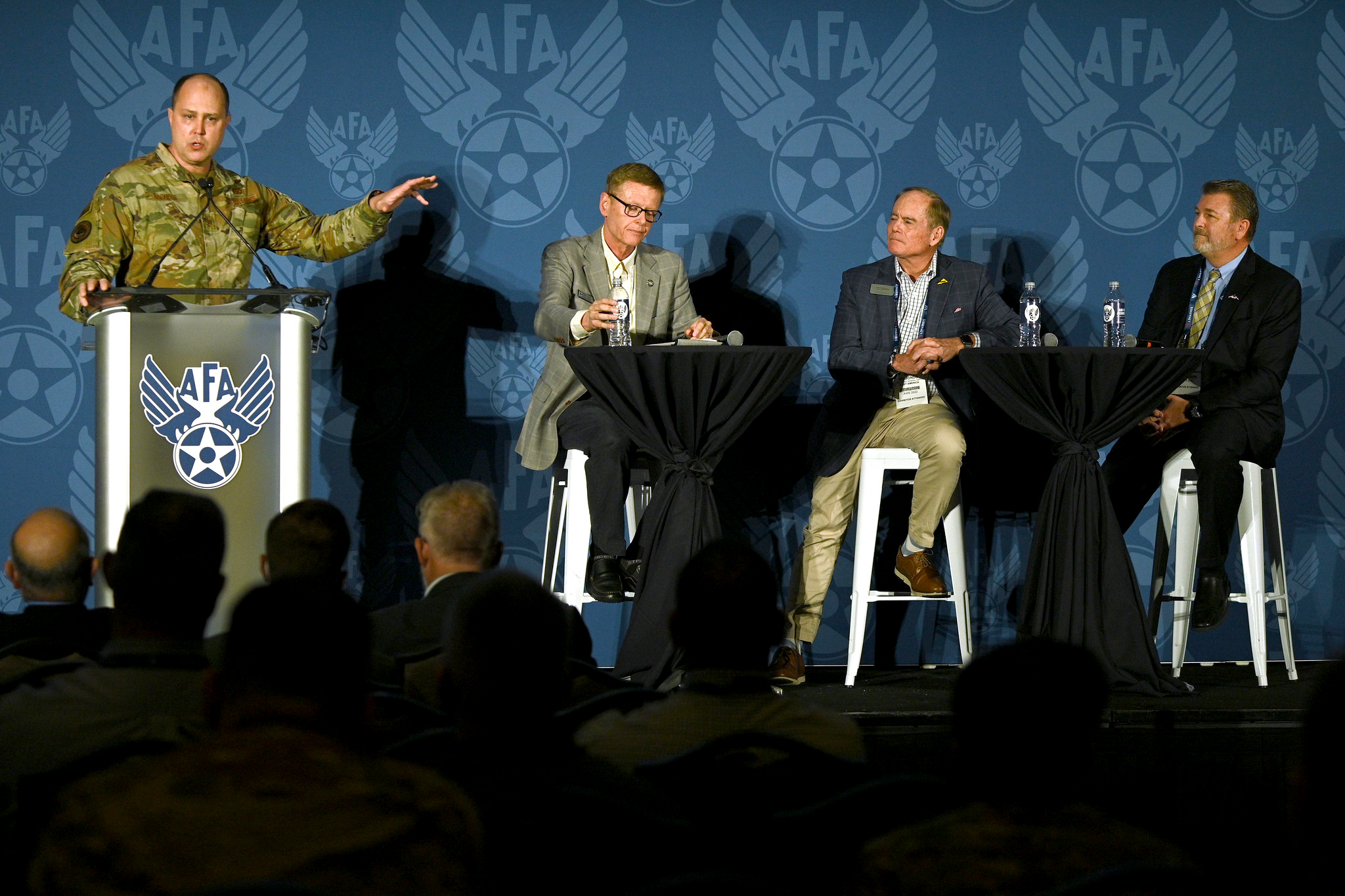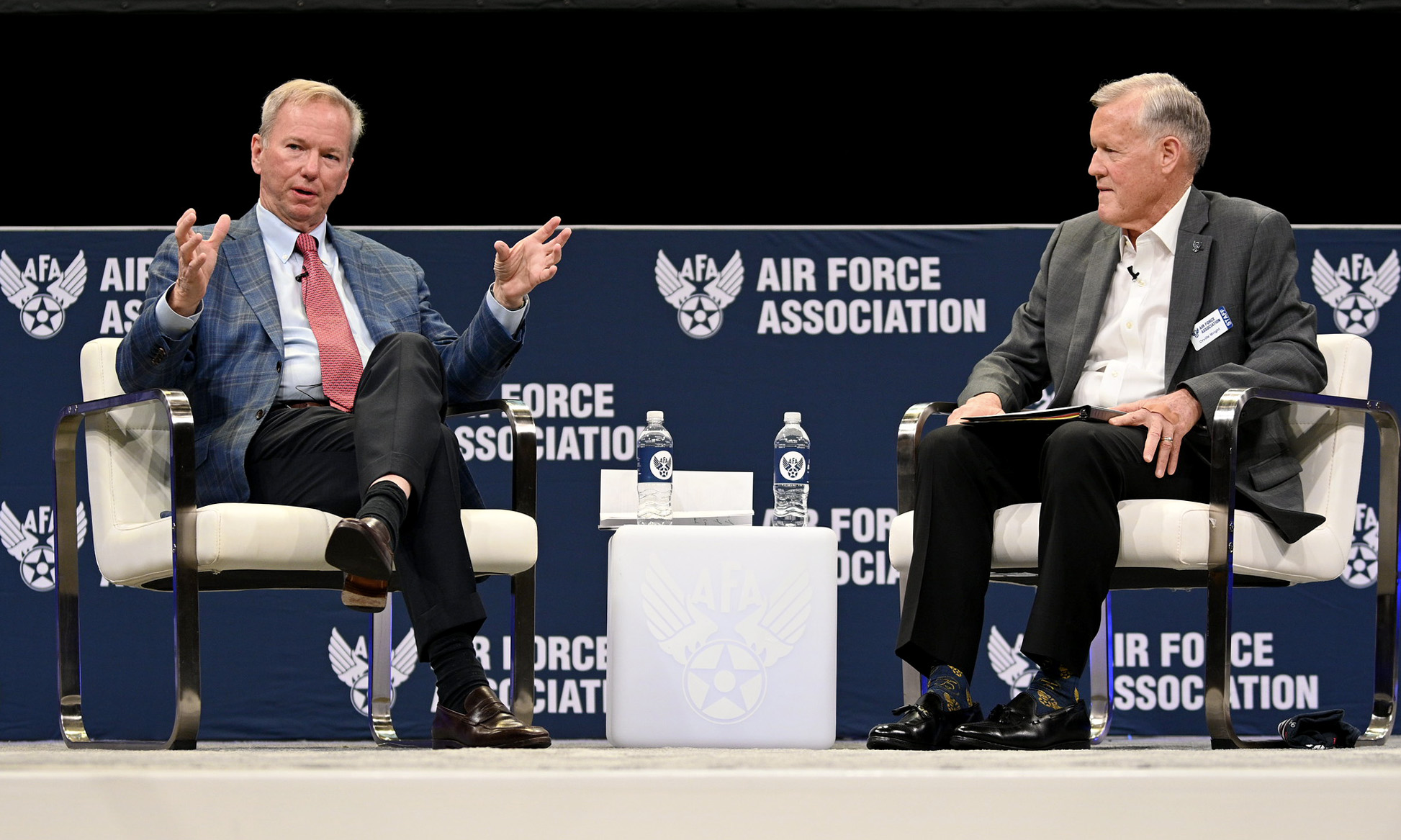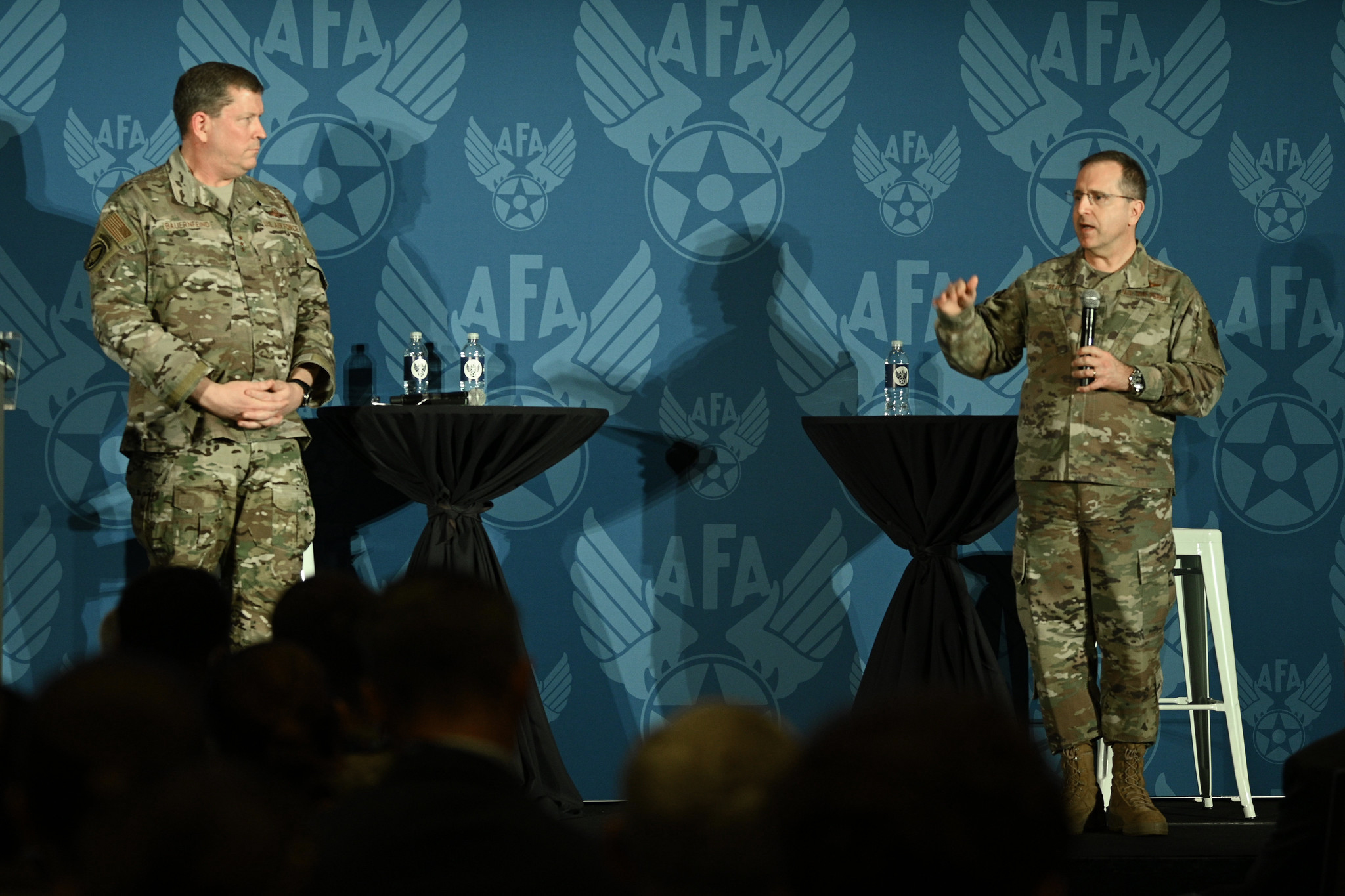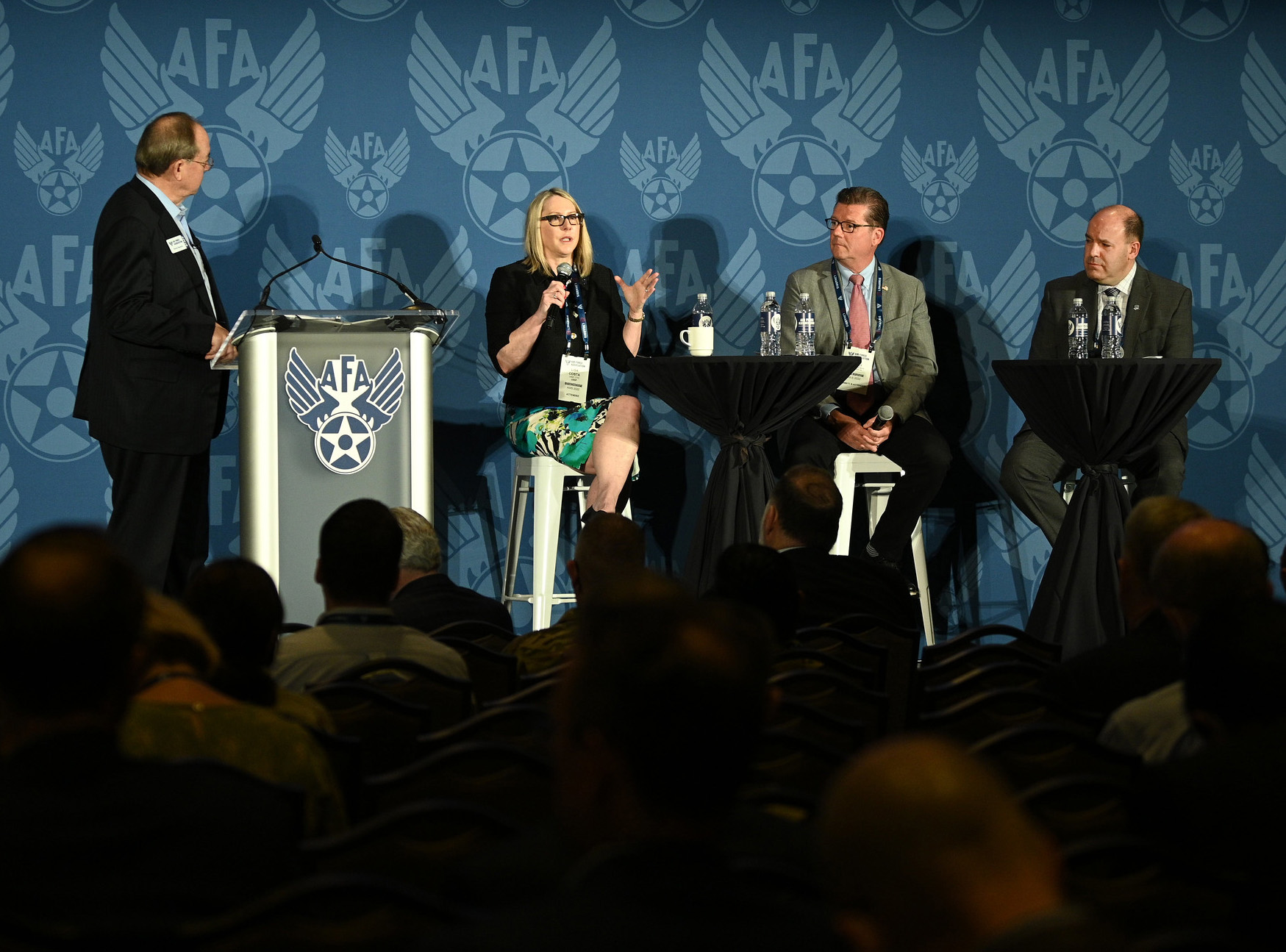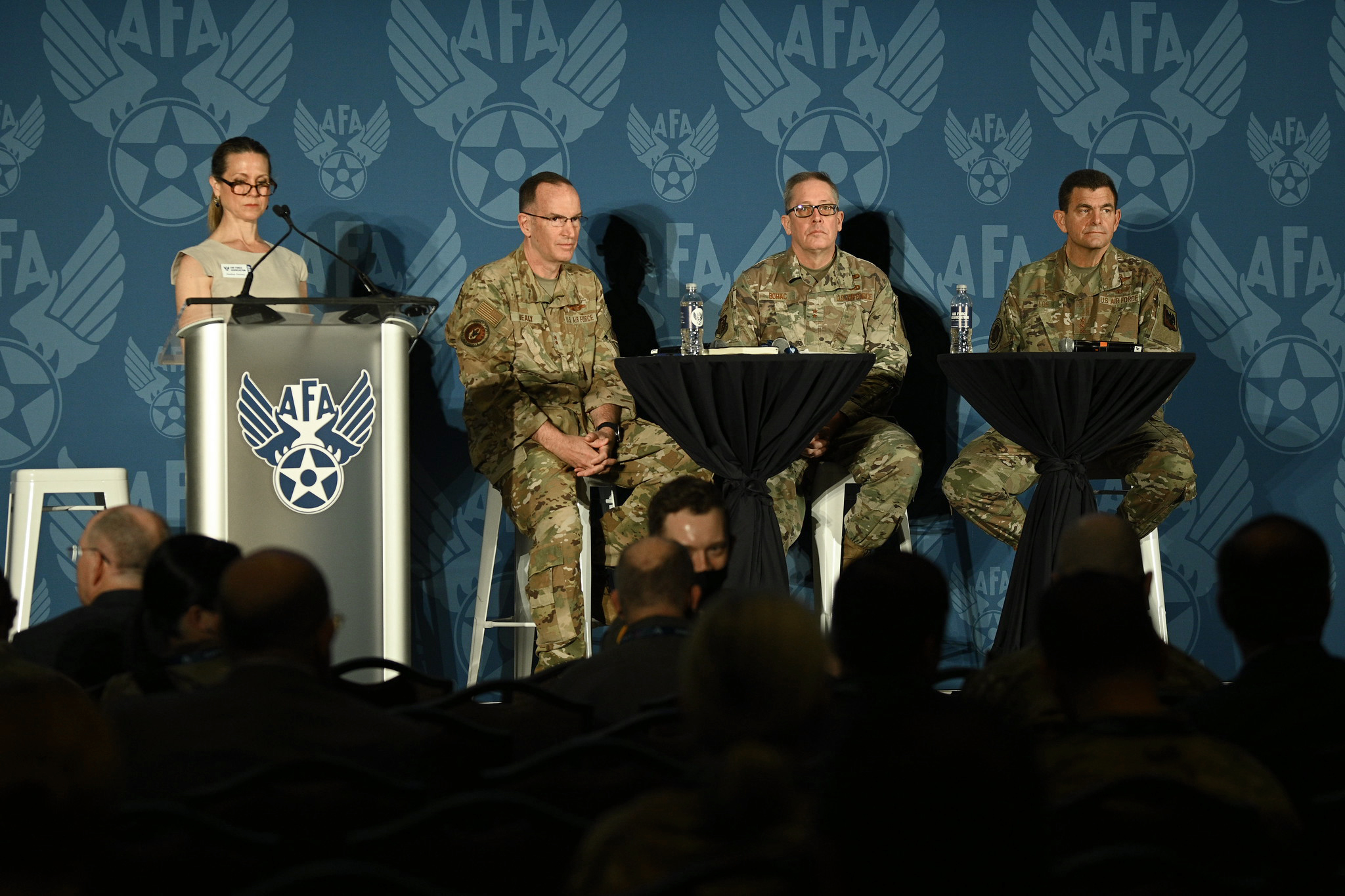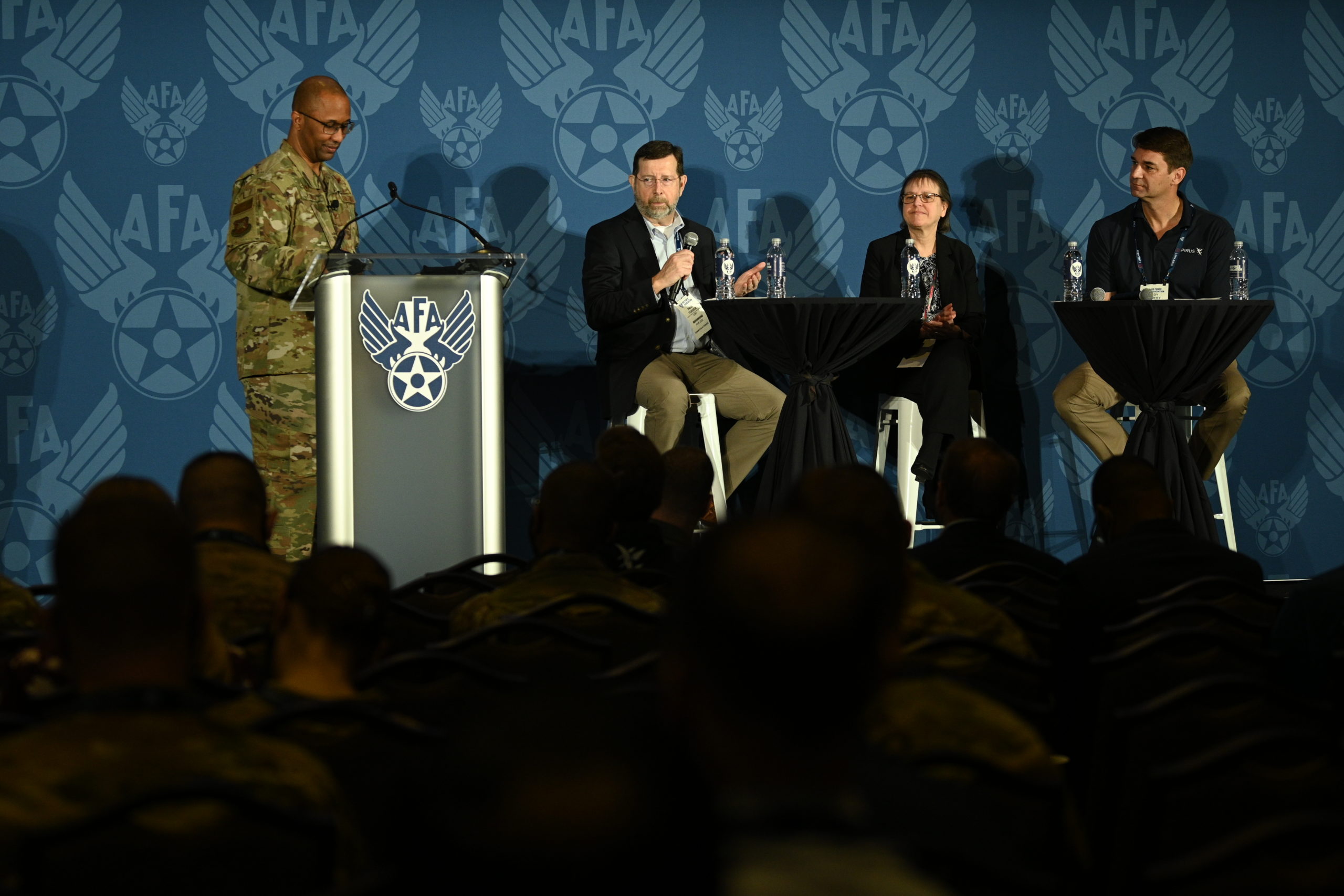Former Air Force Chief of Staff Gen. John P. Jumper hosts a discussion with Chief of Space Operations Gen. John W. “Jay” Raymond and Chief of Staff of the Air Force Gen. Charles Q. “CQ” Brown Jr. titled “Airmen and Guardians in the Fight” during the AFA Warfare Symposium on March 3, 2022. Watch the video or read the transcript below. This transcript is made possible through the sponsorship of JobsOhio.
Overhead voice: Ladies and gentlemen, please welcome the 17th Chief of Staff of the United States Air Force, Gen. John Jumper
Retired Gen. John P. Jumper, 17th Chief of Staff of the U.S. Air Force: Well, thank you. Thank you, everyone. Thanks to Air Force Association for this unique opportunity to have our two service chiefs on the stage at the same time. Gen. Brown, chief of staff of the Air Force, Gen. Raymond, chief of Space Operations, thank you so much for joining us in these turbulent times. I can only imagine what your days are like. Of course, this is the 75th anniversary of the Air Force. Some of us of a certain age were there when the Air Force were born. I was 2 at the time. And then I celebrated my 75th personal anniversary when the Space Force was born. So I’ve watched it all and been with some legends. And I know that you all have been through quite a bit, but, CQ, talk a little bit about the 75th anniversary of the Air Force.
Gen. Charles Q. “CQ” Brown Jr., Air Force Chief of Staff: Well, it’s a big deal, as you might imagine, and it’s not just the Air Force, but the department and what we’re able to do together. And it’s exciting as, I would say, the older sibling to work with someone I’ve known for a number of years, as we work together to, as the secretary talks about “one team one fight,” but also two separate services that over time, you know, our culture will be embedded in them. But there’s some things we’re gonna learn from the Space Force as well. So we’re pretty excited to have them as a partner.
Jumper: Well, little brother, how do you, uh?
Gen. John W. “Jay” Raymond, chief of space operations: First of all, I’ve been an Airman for 35 and a half years, and I’ve been a Guardian for two, and I celebrate the Air Force’s birthday as well. We’re one team, as the secretary said. The secretary said that from day one, and we are one team. But I think we are better than one team with having two independent services.
Jumper: No doubt.
Raymond: And I think the strength that we all bring now, where Gen. Brown and the Air Force are gonna focus on their domain and my team can focus on the spaceman, will make us an even stronger department.
Brown: It takes two of us to do what you used to do.
Jumper: Absolutely right. Absolutely right. And do it a lot better, I might add. Well, I remember growing up, my dad was in the Air Force. So, I grew up; he was a test pilot, and I grew up with Chuck Yeager, bouncing on his knee, and some of the legends of the Air Force. I remember when Curt LeMay came to visit Tactical Air Command and I was the executive officer for Gen. Creech—Bill Creech—one of the most ominous figures, but not as ominous as Curt LeMay. And it was the only time I ever saw Gen. Creech nervous about anything is on the day of Curt LeMay’s visit. And, Jay, I was, I think, the last chief to be able to host Gen. Bernie Schriever at the Air House. He died in 2005. And I was the A3 when Tom Moorman was vice chief. So you know, I got to see the ushering of the space era and with these heroes of the Space Force, so I take it as a great privilege. So let’s get right into it. This is a unique opportunity to have our chiefs on the stage. Our theme for this is air and space power to deter, fight and win. Secretary Kendall has talked a great deal about the investments that China and Russia have made to deny our ability to project power. Both of you have talked about the race for technological superiority, and you’ve talked about delivering space power at relevance to the speed of relevance. How do we think about this global environment and what we’re doing to sort of stay ahead?
Raymond: Well, I’ll start, and I think you’ll find when we have these discussions that my good friend—and I mean that; we went to ACSC together years ago; we’ve known each other most of our entire career, and it’s a privilege to serve with you. I think you’ll find that we see a strategic environment very similar. I think the secretary laid it out really well in his speech. It’s a global, dynamic—probably the most dynamic and complex security environment in three generations. And I will tell you, on the space side of the house, the Air Force built the world’s best Space Force. We’ve had the best capabilities, the best people. We’ve integrated them most effectively into the fight, starting with Desert Storm. But I will tell you, it’s a service that was built for a different domain than we’re operating in today.
If I were here three years ago, I would have told you we were tracking about 22,000 objects. Today, we’re tracking close to 50,000 objects in space. Three years ago, I would have told you we were tracking 1,500 satellites. Today, we’re tracking almost 5,000 satellites. In fact, about two hours ago, we just launched another 47 out of Cape Canaveral supporting a SpaceX launch. In fact, that one company, SpaceX, in the last two years has launched more satellites than we were tracking. … And then if you look at those capabilities, and you look at what China and Russia have done, but I’ll focus on China, and have integrated those capabilities, into a warfighting architecture, that if deterrence were to fail, we are now going to be up against an adversary that has the same advantages that we’ve enjoyed. And they’ve built it over the last 30 years. And they’ve built it for a purpose. That coupled with the spectrum of threats that we’re seeing from low end, reversible jamming to high-end kinetic destruction, it’s a different domain … and it required a different approach.
And so our country, before it was too late, while we’re still the best in the world, decided to make this service an independent service and to allow us to focus on, as the secretary said, delivering war-relevant, military-relevant, capability and to do so at speed. And I think there’s great advantage with commercial industry that’s out there. That’s really, again, I’ve used this word, a terrible word to say in the space business, but it’s been an explosion of business that’s going on. We want to be able to leverage that. And we want to be able to leverage them. So great to see our international partners here. And we have opportunities to do things together with international partners that are pretty special.
Brown: I really think about the complexity, how things have changed. I was reflecting as we came down here to Orlando: It was two years ago, we’d just finished up AFA, and, I was at, we were in Tampa visiting our son. I was sitting on his couch, doing his taxes. And my phone started to explode with texts. And it was the day I got announced as the next chief of staff, and it was, COVID hadn’t really started yet. And so I’m really thinking about how the environment has changed, really not just in the past two years, but throughout our careers. And the aspect of, you know, in the Cold War, Middle East and now back into great power competition. I was just listening to a podcast last week that said, ‘Did the Cold War really end, or did we just have an intermission?’ I mean, think about what’s occurred really over the course of the past month, and not to mention what’s going on with the U.S., Russia, and Ukraine, but what’s going on … in the South China Sea and all the incursions by the PRC into Taiwan’s airspace. The fact that a leader from ISIS was killed, which means they’re going to create another leader, and it’s not going to go away. And North Korea has been launching missiles on a regular basis. And so it’s an aspect of challenge that we all face.
But at the same time, the access to information that we have. And so the world moves at a different pace. And so that’s the thing I, you know, as I think about where we are as an Air Force, as a department, as a joint force, and with our allies and partners, it’s all the things that we have to do together to make our success successful. So when I think about the Air Force, even, I would say back at the beginning of my career to where we are today, is we still got to defend the homeland. We got to protect airpower globally. And then we got to work as part of a joint ally and partner team to deliver a capability. And I think one of the key partners is Space Force. And the aspect of what we’re able to do together and having, you know, Jay and Mollie, that Sharene and I have known since Air Command and Staff College. I mean, you couldn’t ask for a better partnership. And I think it actually, the fact that we are two separate services, actually, you know, I almost dreaded the aspect of having to do what you did, which is fully understand, and I probably would have not done space capability as well as we’re able to do today by being two separate services.
Jumper: It’s absolutely right, CQ. I couldn’t agree more. You know, I like to talk about the integration of the vertical dimension. It’s more than that, I know, because now we got cyber in that equation as well. But the fact that we’ve talked about domain integration, both of you have, and the fact that we have the means now to get relevant information to the people who need it more quickly, and it’s this sort of a, you know, in Kosovo, I recall everybody celebrating these chat nets that we had among our platforms, and they were celebrating doing things at the speed of typing. And I said, ‘No, no, we got to do this to the speed of light.’ And here we are now. We have this opportunity. And you guys have been talking about it and made it and making it come true. Huge. We’ve come such a huge way. Considering the short term, first of all, we can’t seem to break away from the world of continuing resolutions. Let’s set that aside for a second. But can you comment on sort of your short-term goals? And, you know, the most urgent priorities each of you are dealing with, sort of right now?
Brown: Well, sure, I think one of the things that the secretary kind of highlighted was bureaucracy, the ability for us to make decisions faster, and it’s the aspect of, you know, my goals are really laid out in the action orders. And, you know, just this last month, I actually updated the action orders because the Accelerate Change or Lose is really the enduring part of what I’m focused on. And I think that’s something we got to pay attention to, but it’s also the aspect of the action orders. And the reason why I did the modifications, because as you get into this, you figure out that, you know, the facts and assumptions always change based off the original plan. And so it’s really, you know, how do we take care of our Airmen, you know, things like a static closeout date on our OPRs. It’s the aspect of how we work resilience for our Airmen and our families. It’s working through the bureaucracy; it’s introducing the staff to the staff. What I mean by that is, how we collaborate better. It’s how we deepen our understanding of the PRC with Action Order C on competition and Action Order D on design implementation. It is doing exactly what we did last year, being on the same page with our senior leaders and communicating off of one page. And that’s an aspect that not only will happen as that ‘23 budget comes out. But as we start to build ‘24, we’re already in the process of starting to build ‘24, it’s really, as I’ve told the staff, that campaign plan for ‘24 starts now. Because we’re on a path to transition to the future. And that’s something I think we got to continue to work on. So those are my goals. You know, those are short term, but they’re also long term as well.
Raymond: I applaud CQ’s Accelerate Change or Lose vision. We see that the same way. It’s a little different for us, though. CQ asked, and the leadership of the Air Force said, Airmen need to make a shift, you have to take a service and make a shift. We’ve been given an opportunity to start with a clean sheet of paper. And so we’re trying to build it differently from the ground up. I was looking outside of this room, and I don’t know there’s probably 1,000, a couple thousand people in this room. If you added another one of these rooms, that’s the entire Space Force. We’re really small. I’m not worried as much about bureaucracy, in that we have a really small bureaucracy … in the Space Force. My challenge, our challenge, is do we have enough mass to be able to operate broader Department of Defense bureaucracy and to be effective.
And so the big thing for us, you know, the first year was largely about inventing the service. And the second year was all about integrating it into the broader department. We’ve got all the major pieces in place now. Now it’s really continuing to deliver and capitalizing on what we built. The big focus area for us this year, and for the next decade, is shifting our space architecture to a new, more resilient architecture by the design of the force. The capabilities that we have in space are exquisite. They’re small in numbers, and they’re not easily defendable. Our joint and coalition forces that require the space capabilities that we provide, they can’t be treated as a given anymore. And so we’re gonna continue to provide those capabilities and do so in a way that’s more resilient, so we can assure that, and we can’t take them for granted.
Jumper: That’s great. That’s great. So, you know, we created the Space Force out of the Air Force using largely Air Force, beginning with our Air Force missions and Air Force Airmen but also the other services and, you know, addressing space capabilities in the other agencies as well. I think we’d like to hear from both of you about how that transition has gone, as far as, you know, the separating the missions and how we’ve addressed the people issues going into this transition.
Raymond: I think it’s gone extremely well. I would have flunked the test if you’d have told me we were as far along as we are in just two years. We couldn’t have done that without the support of the Air Force. And so the relationship we have is hugely powerful. And it’s, again … there’s no way we could have done what we’ve done without the support. So I thank you, and I thank all the Airmen that are helping us. It’s been a very powerful partnership. If you look at you know, today, we’ve got just shy of 7,000 folks in Active-duty Guardians. We’ll grow by the end of this year to about 8,400 … maybe 8,436, I think, is the exact number, but about 8,400. It’s interesting, by the end of this year, we’ll have 8,400 people; about a third of those will have never served an Active-duty day in the Air Force. And so we’re building the service with a culture that that brings in folks from multiple services to be able to do this. And again, we think that’s going to be really, really powerful.
I think the biggest one of the biggest things that we’ve done, as we’ve built this service, and you touched on it as the personnel side, when you have a service that only has the numbers that we have, you can do things differently. I remember one of my former bosses used to talk about the art and science of professional development and that when you have a service that’s really, really large, the science kind of takes over or the machine takes over … because you have to. When you have a service our size, you can do things differently. And so we’ve built a strategy that allows us to have a little bit more art, apply a little bit more art to the professional development of our folks because we can, and we want to take advantage of that luxury, and really, really make a difference in our Guardians’ and their families’ lives.
Brown: I couldn’t agree more with Jay. I think the transition’s gone very, very well. And it’s the aspect of the mutual support that we provide, you know, for those that operate in the Air Force, we talk about mutual support, it’s really having each other’s back. And the aspect that, you know, there are so many Airmen that help the Space Force do what it does based on the way the law was written, how we wrote the various specialties. But it’s also the dialogue we have. And I’ll tell you that each one of us Airmen are probably a little bit smarter about space because of our close relationship with Guardians and the things that they’re able to do. I think the one thing that Jay and I talked about, as he came in this position, was the balance of how much do we, you know, hug each other close and how much do we let them, you know, kind of spread out and grow.
And I think the other thing that’s very helpful to us, because they’re actually able to go do some things at a smaller scale. It’s a forcing function for us as an Air Force, because there’s some things we can learn. There’s some things, you know, you got a toddler, if it’s running around at 2 years old, you got to chase them. Sometimes you’re chasing the Space Force a little bit to kind of go, ‘Hey,’ you know, so we can be on the same page on some of these things, because there is a balance. Because, you know, I’m going to look at the Space [Force], the Guardians, and go, ‘Well, we want to do that too.’ And I go, ‘Well, you know … we’re not gonna be able to do all that. We can do some of it.’ But I think there’s real opportunities for the dialogue. And then I think that the last thing I should share on this is, I mean, we are so intertwined, we are so dependable on each other, not just from a, you know, base operating support construct, but operationally. We cannot do what we do as a joint force without the Air Force and the Space Force. Not to disparage the other services, but the relationship we have makes a lot of things happen around the world with our allies and partners. And so that to me is, if we don’t have a good relationship, then it’s going to be a bad day for somebody. But it’s going to be a bad day for our adversaries because of this close relationship between the Air Force and the Space Force.
Raymond: I couldn’t agree more in. And what we’re committed to doing, we enjoy a great relationship because we’ve known each other for almost our whole careers. We want to build this in a way that it isn’t just strength of personality, that it’s built that way to stay connected and to continue to deliver that great advantage. That’s another area that we work really closely on.
Jumper: I think that’s an advantage of being in the Department of the Air Force. It gives you this natural closeness. How about the other services, Jay? How’s that gone trying to integrate with the missions and the people of the other services?
Raymond: I think it’s gone very well. … That’s been one of the benefits of having an independent service. We can, I can, now go directly to those other services. We’ve got done a lot of analytical work with the Navy. We just signed an MOU with the Army on tactical-level ISR. I think it’s, one of the things that Congress highlighted when they were debating whether to pass the law on an independent service. There was a few things that they highlighted. One was professional development, types of shortcomings that they saw. One was the ability to integrate. There was 60-something people in the Department of Defense that could say ‘no’ and nobody could say ‘yes.’
So today, now working with the JROC, the JROC has designated the Space Force as the lead integrator for joint space requirements. That’s a huge deal. Though the National Defense Authorization Act that was just passed said … the secretary defense will delegate to the Space Force the force design work, so no longer do you have 60 different people trying to come up with things. Our goal is to drive that unity of effort across the department and then get everybody rowing in the same direction and then tee that up for the secretary of the Air Force and the DOD’s governance structure to make the decision. And then we can move out at speed and reduce duplication, reduce costs.
Jumper: Great, great. We mentioned earlier the continuing resolution. I think probably every service chief for the past couple of decades have had to deal with a continuing resolution or sequestration or government shutdown or some other bump in the road in the budgetary process. And it is really an impediment to progress. Could you all just comment on the risks of not having an approved budget?
Brown: Sure, I almost want the whole audience to repeat after me, you know, ‘CRs are bad.’ They’re frustrating. It just, the aspect of what we’re not able to do because of CRs. And so as we, you know, we had to testify before the [House Appropriations defense subcommittee] back in January to really look at CR and the potential for a yearlong CR. And we talked about buying power and the like, and so I asked my staff to actually pull something together for me, and the fact is that over the past decade, we’ve only passed one budget on time. If you add up all the time we’ve been in CRs, it’s been over three years. So basically 30, you know, 30 percent, of the last two FYDPs. And I equate that to the aspect of, if we were, you know, in a race with somebody, we just spotted them three years. We can’t keep doing this. We’ve got to get past this because this slows us down from being able to have trust and confidence with our Airmen, trust and confidence with industry, trust and confidence with allies and partners to be able to provide the capability that we’re going to require as we move forward.
And so it drives a, you know, the risk of being able to move forward. And it’s in warfighting and impacts our ability to war fight, impacts our ability to do foundational-type things, to do our foundational pieces … to take care of our Airmen, families, infrastructure, how we work with the combatant commands, the Guard and Reserve; it drives a risk in execution, because we’ll build a good plan, but then we can’t execute it partly because of the CR. And then it impacts our industrial base and our ability to commit to moving things forward. So it drives risk in some key areas. And I just, we got to quit doing this to ourselves. It’s become a habit.
Raymond: CRs are bad, and a yearlong CR is unprecedented. With the three years that Gen. Brown just identified under a CR, we have gotten good at bad behavior. We’ve gotten good at pushing contracts to the end of the year. We’ve gotten good at doing things that we had to do because we didn’t have the resources to do it or a law that allowed us to do it. Can’t do that with a yearlong CR. A yearlong CR for the Space Force is a $2 billion hit to the top line. A yearlong CR to the Space Force, which is a startup—if you’re a startup company and you can’t do new starts, it’s really hard.
And so it impacts our modernization. It impacts our pivot to a resilient architecture. It impacts our readiness. It impacts our being able to develop training capabilities and testing capabilities, and it impacts our Guardians and their families because we rely very heavily on the Air Force for those types of programs, with PCS moves and all those things that would be impacted: accessions and retention. And it impacts our ability to continue to establish the service. We’ve identified missions that are going to transfer from the Army and the Navy into the Space Force, where they’re identified. All the people have volunteered. I’ve been on the road here recently visiting them overseas and in CONUS. They’re eager to come. We can’t bring them in until the law is passed. So it’s something that we’ve got to get done. And a yearlong CR would be absolutely devastating to us.
Jumper: Well, it’s hard to Accelerate Change or achieve the speed of relevance if you don’t have the means to do the acceleration. And I just hope that, you know, the current events of the world can help us realize that this acceleration and these developments in space … we need to move on with it and hopefully get around the bureaucracy. Secretary Kendall and both of you actually have spoken out about the industrial base. How would you describe the current state of the industrial base and particularly how we leverage partnerships with the private sector?
Raymond: I think in the space domain, we’ve learned a lot about the industrial base, especially under the pandemic. It forced us to understand it better. I think in a report, there’s been a couple reports on the industrial base that have just come out—one the deputy secretary of defense chartered, and then there’s one that focused on space. And the one that focused on space talked about how it is tactically strong but strategically fragile. We’ve got a lot of folks, a lot of, I mean, there’s a lot of opportunities to expand this industrial base to get a lot more … innovative players into it, which is what we want to do and support that. And we think there’s some opportunities here. … And this report identifies opportunities for like a national-level vision on an industrial base. How do you advantage democracies to be able to do that? I think there’s great advantages of the partnership between DOD and industry. And that intersection of those two will provide value. We’ve seen similar upturns in the space industry back in the mid-’90s. There was a satellite constellation called Iridium that survived—66 satellites. There’s something called Global Star. There’s something called Teledesic. None of those survived; none of them materialized. We need this to materialize. And in that partnership between government and industry is something that we think will help both of us.
Brown: Like Jay, I would say it’s fragile. I think we’ve gotten, in some cases, so efficient in certain areas, whether it’s the industrial base in the commercial sector—I would also say, bits of our depot as well—that we want may not be effective in the future. If we had to surge, we’d be challenged. I get worried about the the age of our fleet, and you look at diminishing manufacturing sources, where the company that actually built this particular whatever, whatever it is, doesn’t exist anymore. You have to start from scratch and start over. It’s the aspect of our workforce and our relationship there that they actually have the talent to continue to innovate and move things forward. Because we haven’t put as much into R&D or the aspect of STEM education, those kinds of things, because you want that workforce to be here when we need them. And then it’s the ability to diversify. And it’s not only working with the five but also working with smaller companies.
And I’ve had a chance to meet with a number of smaller companies—venture capitalists—and they’re all patriotic, and they want to work with us. But we can’t make it so hard to be able to, as the secretary talked about it, and the secretary and I’ve talked about it, you know, the valley of death and the aspect that there’s a lot of innovation on one side of the valley, a lot of interest on the other side; we just can’t get the two of those to meet. And what we’ve got to do a bit better is how do we work with, as we work with industry, it’s the aspects of being able to use the operational imperatives—put operators with the technical experts with acquisition professionals with industry, to be working more closely together. It’s all about collaboration to buoy these things forward. And I think it benefits all of us because it’s really about our national security, whether it’s those of us that wear the uniform or work in government, but it’s also with industry and how it impacts our economy. So it’s something we got to really pay attention to. We do not want this to atrophy and then wish we had it at a later date.
Jumper: Well, the good news is that our Secretary of the Air Force, Frank Kendall, is … probably no one on Earth is more knowledgeable about how to connect these dots and work these things together than he is. And I think we’re blessed to have his wisdom helping us out with these things. There are many initiatives underway that make our force more agile, more survivable, both in air and space and sort of a more of an expeditionary mindset. I think these are fundamental changes. And as we’ve already talked about, a lot of these things need to happen rapidly. Would you talk about how the Air and Space Force are thinking about these fundamental shifts in the way we go to war, and I’m thinking about dispersed operations and the, you know, the changes and more tactical uses of space, etc. These fundamental shifts that are taking place? How do you all think about these things?
Brown: Well, you know, you mentioned expeditionary. So, we have been expeditionary for the past 20 years to static locations. We’ve gone to the same places for the past 20, well, actually 30 years, for the Air Force in the Middle East. And so we’ve gotten used to going someplace where everything’s all set and ready to go. You don’t have to worry about … you don’t have to set anything up; it’s already there. In the future, we’re gonna go places we haven’t gone to before, particularly if you think about the Indo Pacific and the ability then to, it’s the aspect of not only the capability to be able to do this, and this is where the operational imperatives come in. This is where, you know, Secretary Kendall and his vision to be able to, his expertise as well, you know. I joke about it that he wrote the book on acquisition, and I have a signed copy. So he understands this better than the two of us put together probably. And that’s helpful to help us drive ourselves in the direction, to think not so much differently but to really bring the team together to drive us and bring these aspects together.
I think the other thing that I think about as we move forward from a wartime perspective is the aspect—and Cruiser [Gen. Kenneth Wilsbach] talked about it earlier—agile combat employment. There’s a capability, but it’s also the mindset of our multi-capable Airmen, the ability to not only go into a base that you haven’t gone to before, set things up, tear it down and move around, but it’s the ability to stretch our Airmen and allow them to use all their skills and talent, which is, you know, when we changed our doctrine to mission command and talked about centralized command, distributed control, decentralized execution, it’s the aspect of being able to work small teams and trusting our Airmen to be able to do things. And they trust their leadership, and we provide them the intent and the resources to be able to do that. And that’s why the operational imperatives are so important, to provide the resources and that we provide the mindset and training to get them there to be able to execute. Because conflict in the future is gonna be much different than it is than, you know, what we’ve been doing in the Middle East. And that’s something we got to really change ourselves. And, you know, you tie that to a CR. If we’re not changing that, not changing the CR piece, we are going to regret it later.
Jumper: Absolutely.
Raymond: I don’t know how many times CQ and I have, after we come out of meetings with the secretary—who is masterful, masterful at his knowledge of how the building works and how to do all the programmatics—and we were like sitting there; man, we’re like little kindergarteners watching the professor really drive great advantage for our service and for our nation. It’s a privilege, sir, to work with you. I mean, if you think about what Gen. Brown just talked about and how warfighting is going to evolve, you also have to understand that that evolution is going to take place with an adversary that has—if deterrence were to fail—with an adversary that has incredible space capabilities for their own use, that’s integrated into everything that they do.
So as the Air Force needs to be agile and move, people are going to be watching. And so it’s going to require a different mindset for us as well. We’ve got to be able to—in space, as a warfighting domain—you have to be able to make sure that all the other services can do what they need to do to get their mission done. That requires strong space capabilities as well. The other thing is, as countries are developing capabilities to deny us our access to space, we can’t take it for granted. And you got to be able to protect and defend it. As you become more agile and more dispersed, you also have to be able to bring data from space down and get that into the hands of the folks that need that information. And so the work that we’re doing to develop tactical-level ISR requirements for the department and then figure out how best with our intelligence community and partners to satisfy those requirements and then task and distribute data to the joint force is going to be critical.
Jumper: That’s great. It’s a new level of, sort of, tactical capability in space that we really have never gotten to before. CQ, I, you know, this idea of being truly expeditionary, I think, is fascinating for some of us old guys, who at the front end of the AEF, we got trapped into this static situation. But what we also learned in that period of time was that part of our core competencies need to include security outside the fence—engineering, maintenance and sortie generation, some of these things that go into fundamentally fighting in any situation but certainly in the more dispersed world. So how do you look at this development of these competencies? I know you got a lot of things underway here.
Brown: Well, you know, when we talk about multi-capable Airmen, it’s one part of the doctrine. But it’s also the mindset and to allow them to trust themselves that they can do these things. And it’s really thinking differently about how we operate. And so really, in some cases, I think about how we do this with a clean sheet … because we will try to follow an AFI. And I will tell you just, you know, I tell Airmen when I travel is, you know, we have a lot of AFIs, but then COVID—we probably didn’t pay attention to them as closely as we did before COVID, which provides us an opportunity. And oh, by the way, the setup of a separate service gives us another opportunity to take a look at this. So it’s a bit of the mindset.
And, you know, I was talking to one of our wing commanders recently, and they were building their training program for multi-capable Airmen, and I go, ‘Stop. I don’t need a letter of Xs to track multi-capable. I want a mindset of Airmen that actually think differently and challenge the status quo of how we might operate.’ Because particularly our young Airmen who actually are getting the job done are probably or really more innovative than I am in certain areas. I just need to be able to understand what it is they’re trying to get done so that I can support them. And so it’s really, you know, being able to really think differently.
And then, technology is much different. You know, I was talking to some Airmen this past week, so, you know. I didn’t have an email address when I came into the Air Force. I think that my first email address was when I was a captain, which tells you things have changed. So we’ve got to change too. We’ve got to be able to drive ourselves to look at things differently as you do expeditionary operations and really redefine. You really made me think about it: We need to redefine ‘expeditionary’ from what we did during the AEF construct to where we’re going to go today.
Jumper: That’s right. Agility, we never really achieved the agility we were striving for because the conditions were different. We got to get there now.
Brown: Exactly.
Jumper: I think all of us appreciate what you, Gen. Kelly and others are doing for the expeditionary mindset. This generation of Guardians and Airmen wear the uniform, and time’s much different than many of us grew up in. One thing I’ve always found true is that any generation has always sought the ability to be a part of something bigger than themselves. This pride in the mission, pride in themselves. Talk about this current generation of Guardians and Airmen and what we have today.
Raymond: They’re incredible. I mean, they’re way smarter than I am. And my college roommate’s here somewhere, and he’ll vouch for that. They’re collaborative; they’re connected. They want to serve. They are bold. They’ve got ideas. And it requires a different leadership style. It requires less AFIs and ‘here’s how we’re going to do business’ and more open to choices in their ideas. And I think if you engage with them early, you’re going to have, it’s going to be very helpful. Chief Towberman, our Chief Master Sergeant of the Space Force, has really been working this hard. We’ve developed a human capital plan that we call the ‘Guardian Ideal’ that gets after this.
I was thinking about this a couple of days ago. I was in Japan back in 2011. And it was shortly after the big earthquake, and there was a tsunami that was coming in—not a tsunami, I’m sorry, a typhoon that was coming in. And we all got sent home, and schools got released. We were all in our home. And we have three children that were home at the time—two that were freshmen in high school and one was in middle school. And the power goes out in our house. And my daughter comes up to me, and at the time, I was the Fifth Air Force vice commander; my boss was TDY. So I was kind of the senior guy on base, and my daughter comes up to me and said, ‘Hey, did you know that there’s, how come we’re the only house without power?’ I said, ‘Christina, the whole base is without power, you know, a big, big storm.’ She said, ‘No, there’s a tree across the road down by the hospital. And it’s hit something.’ I said, ‘How do you know that?’ She goes, ‘Well, none of my friends have posted that they’ve lost power. And here’s a picture of the tree that’s down.’ And no kidding, 15 minutes later, the wing commander calls me and said, ‘Hey, Gen. Raymond, I just want to let you know, we’re sorry that your house is without power. We’re gonna get it on. There’s a tree down.’ Well, if you look at the space domain, we experience the space domain through data. We don’t live there unless you’re an astronaut. And so having young Guardians that are connected, that are digitally fluent, and we’re spending a lot of time and effort building that digital fluency across the force, to be able to take that data, harness that information and get that information in decision-makers’ hands and push those decisions down to their level.
If you look at conflict, if it were to extend into the space domain, I mean it’s going 17,500 miles an hour just stay in space, across vast distances. You can’t do that the way we normally do business. So this service that we’re building is really being built by our young Guardians for our young Guardians, and we’re gonna be better off.
Jumper: I have a 6-year-old granddaughter that’s ready to come work for you. I say, ‘Honey,’ she wants to play on my iPhone, ‘Honey, can I set that game up for you?’ She said, ‘No, Papa. I’m very, very smart on computers.’
Brown: Well, you know, I can’t top Jay’s story or yours for that matter, but I really do think about this generation as they come in and the aspect of how connected they are, how much they want their leadership to know them and care, and that’s the thing that I’ve found. And they really want to contribute. And we got to make sure we get out of their way to allow them to contribute. And so that to me is the exciting part. And if we don’t get it right, they’re not going to stick with us. And we got to really think about that. And … this is another reason why, you know, you think about the tools we provide them. We want to make sure that they don’t have to step back into the ‘80s when they come to work each day.
Jumper: Our Airmen and our Guardians keep us grounded. They do. As the senior leadership, they always have, and I’ve always appreciated that about being able to visit the force. Gen. Brown, last year, you and the commandant of the Marine Corps authored a discussion about readiness and risk. And we talked about a lot of that stuff already. But in the situation we’re in today, how do you look at the risks and the challenges for sustaining Air Force readiness at the level that we need it to be confident in our missions?
Brown: Well, it’s a challenge, because the United States Air Force is very popular. And I joke about this, but I feel like a chew toy between combatant commanders, where they’re pulling and asking for more and more Air Force capability to go to different places. Because the United States Air Force is the one service that can get there faster than anybody else, except for the Space Force; 17,500 miles an hour, we can’t go quite that fast. But we can get there and do things in hours and days that may take others weeks and months to do. And so with that, we make it look too easy.
And this is a good reason why I went working with our leadership on our Air Force Force Gen model, which is kind of based off the AEF. But we really want to be disciplined about it and be able to use it to show what the risk is to the readiness. And that has been the challenge. And so the other part for the Air Force is we got to be a little more bold. We’ve got to speak up for ourselves and show what the impact is. And that’s something I don’t know that we’ve done very well. It’s something I’m focused on. And this is why, you know, myself and the Commandant have the same perspective. We talk on this topic very often. And we got to do a better job of talking about the, you know, what happens to our readiness if we continue to use our capabilities at the rate we do and we don’t modernize. You got to look at it from a broader perspective. And I think if you look at current events today, with Russia and Ukraine, and our pacing challenge, we got to be able to walk and chew gum at the same time. And we’ve got to really think about how we preserve some of that readiness, but at the same time, assure and deter.
Raymond: For the Airmen out here, you should be really proud of your Chief. He’s the leading voice in this across the department. He’s really pushing it hard with the Commandant. And I think those conversations are beginning to pay dividends. I had the opportunity to be a combatant commander and a service chief at the same time. And what you see different between a combatant commander and a service chief is a combatant commander has a very near-term focus, one to three years, and service chiefs look to the future. And so I had the opportunity to disagree with myself in my two hats. And the cool thing is I won. I really can’t tell you which hat I won in, but I always won. Gen. Brown has highlighted that in a way that I think has helped inform the joint force and will help us build the readiness that we need for for future issues we have to face.
Jumper: In the last few minutes we have here, we have a lot of representatives from our NATO nations and our partner nations here today. And I think we’re watching sort of a recasting of how we view alliances in the current situation. Can each of you just say a word about our alliances and the importance of our alliance partners going into the future?
Brown: Well, it’s hugely important. And as we work on the next national defense strategy, the comment I’ve been making is it can’t just be a line in the strategy without execution. And I really think we got to think differently about how we do our foreign military sales, how do we total development of capability, how we share information. Those are the things that are going to break down some of the barriers. The things that we have to do with our allies, we got to make some things more actionable. You can look at today’s current events of how NATO has really come together for a crisis. But we can’t wait for a crisis. We’ve got to be doing these things on a day-to-day basis. And so that to me is important. The other part for, I think, for both of us, the relationships we’ve built over the years is so important, and the relationships really do matter.
Jumper: Absolutely. I agree with that.
Raymond: On the space side, typically the partnerships over history have been in the civil space side with NASA. And we haven’t had the international partnerships on the national security space side to the level that we need. We need them in a big way with what the domain becoming a warfighting domain. And I think one of the other big areas that we’ve made significant strides is in our partnerships with our allies. I appreciate very much the partnership. What used to be largely one-way data-sharing partnerships are now two-way partnerships. We operate together; we train together; we wargame together; we operate capabilities together. And if we get this force design right, where we build this new design for our space capabilities, we think there’s greater opportunity for allied partnerships and those capabilities as well. So it’s extremely, extremely important, and we’re very grateful to our partners for being there with us.
Jumper: Well, in the last couple of minutes here, let me just give you both a chance to say anything that’s on your mind that hasn’t been said so far.
Brown: Well, first of all, thanks to all of you for being here. Thanks to all the support you provide myself and Jay to do what we do. Shout out to our Airmen and families. I also want to shout out to the team that pulls together AFA year in and year out. And it’s interesting that, so when the first time I had a chance to speak before AFA, I quoted Ricky Bobby. And so the team backstage, before I came on stage, handed me this T-shirt for Ricky Bobby. It’s all about Accelerate Change or Lose. If you’re not first, you’re last.
Raymond: I feel like I’m in the Oscars, the music’s playing so it’s time to go. But let me thank AFA as well for pulling all this together in really difficult times. And sir, I’d like to thank you as well for your continued leadership and mentorship and helping us get this right.
Jumper: I’d like to close out with just a quick statement. Whenever I stood in front of our Airmen when I was a Chief, I always took the last minute to challenge them to step back and reflect on the unbelievable work they do day in and day out. And for the leadership of the services and the leadership that’s represented here in the audience: Those of us, especially those who are stars on their shoulders, we spend our days dealing with problems—problems usually that nobody else can solve. So let me just say to you two: Step back and pat yourselves on the back for the incredible job you’re doing leading our Air and Space Forces today. There has never been a more challenging time. And I think the audience will join me in a round of applause and appreciation for what you do.

